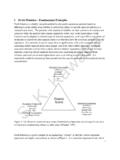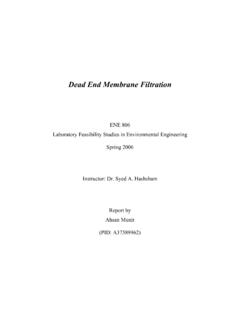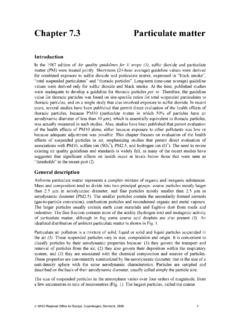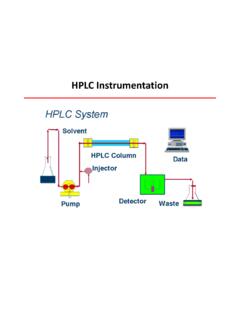Transcription of Water Soluble Polymers - SNF
1 Water Soluble Polymers Introduction 1. Water Soluble Polymers cover a wide range of highly varied families of products of natural or synthetic origin, and have numerous uses. Among these families, synthetic Polymers , and more particularly coagulants and flocculants, are used mainly for facilitating the separation of materials in suspension in aqueous media. They also help to dewater sludge from various separa- tion processes. The separation of solids in a liquid medium takes place rapidly when the density of the particles is markedly different from that of the liquid medium. Either the particles settle out or they float on top of the liquid. Difficulties occur when the particle size allows it to remain in suspension in the liquid medium. In this case, the use of coagulants and flocculants allows separation to be carried out.
2 2 Table of contents 1I INTRODUCTION 1. II TABLE OF CONTENTS 2. III BASIC PRINCIPLES OF COLLOID SCIENCE 6. III-1 Colloidal suspensions 6. III-1-1 Hydrophobic colloids 6. III-1-2 Hydrophilic colloids 7. III-2 Measurement of the concentration of colloids 7. IV COAGULATION AND FLOCCULATION 8. IV-1 Charge neutralization 8. IV-2 Adsorption 9. IV-3 Suspension destabilization by coagulation 10. IV-4 Suspension destabilization by flocculation 10. IV-4-1 Initiation of flocs 10. IV-4-2 Kinetics of floc development 12. IV-4-3 Consistency of flocs 12. IV-5 Other suspension destabilization systems 13. IV-5-1 Encapsulation systems 13. IV-5-2 Two- polymer -component coagulation systems 13. IV-5-3 Microparticulate systems 13. IV-6 Efficiency of flocculation and coagulation 14. Water Soluble Polymers - Flocculation Coagulation Table of contents 3.
3 IV-7 Parameters having an influence on the efficiency of flocculation and coagulation 14. IV-7-1 Influence of the particles 14. IV-7-2 Influence of the Polymers 15. IV-7-3 Influence of the polymer mixing in the solution 16. IV-7-4 Influence of the pH and the temperature of the solution 17. IV-7-5 Influence of the organic nature of the suspension 17. IV-8 Advantages of synthetic coagulants 17. V Water Soluble Polymers 18. V-1 Coagulants 8. V-1-1 Quaternary polyamines 18. V-1-2 PolyDADMAC 19. V-1-3 Dicyandiamide resins 20. V-2 Flocculants 20. V-2-1 Nonionic flocculants 20. V-2-2 Anionic flocculants 21. V-2-3 Cationic flocculants 21. V-3 Amphoteric copolymers 22. V-4 Other Polymers 22. V-5 Products in solution 23. V-6 Branched Polymers 23. V-7 Thickening agents 23. 4 Table of contents VI PHYSICAL FORMS OF Polymers 24. VI-1 Powders 24.
4 VI-2 Emulsions 25. VI-3 Polyacrylamides in bead form 27. VI-4 Products in solution 27. VII CHEMICAL CHARACTERISTICS OF Polymers 28. VII-1 Viscosity 29. VII-2 Measurements of the molecular mass 30. VII-2-1 Light scattering method 31. VII-2-2 Intrinsic viscosity method 31. VII-3 Stability 32. VII-3-1 Chemical and biochemical stability 32. VII-3-2 Mechanical stability 32. VII-4 Ionicity 33. VII-5 Residual polymer content 33. VII-6 Toxicity 33. VIII LABORATORY TESTS AND INDUSTRIAL TRIALS 34. VIII-1 Principles 34. VIII-2 Main laboratory process- Water and municipal- Water treatment applications 36. VIII-3 Use of the Polymers 37. VIII-3-1 Polymers in powder form and in bead form 37. VIII-3-2 polymer emulsions 37. VIII-3-3 polymer solutions 37. Water Soluble Polymers -Flocculation Coagulation Table of contents 5. IX GENERAL APPLICATIONS 38.
5 IX-1 Separation processes using flocculation 39. IX-1-1 Settling 39. IX-1-2 Centrifuging 40. IX-1-3 Belt filters 41. IX-2 Potable Water 42. IX-3 Process Water 43. IX-4 Industrial effluent 44. IX-5 Municipal sewage 45. IX-6 Thickening and dewatering of sludge 46. X SPECIAL APPLICATIONS 48. X-1 Mining industry 48. X-2 The paper industry 49. X-3 The petroleum industry 50. X-4 The cosmetic industry 51. X-4-1 Conditioners and film-forming agents for hair and skin products 51. X-4-2 Thickening agents and emulsion stabilizers 51. X-5 The textile industry 52. X-5-1 Synthetic thickeners 52. X-5-2 Sizing agents 52. X-5-3 Fixing agents 52. X-6 Agriculture-Soil conditioners 53. Basic principles 6 of colloid science III-1 Colloidal suspensions In liquid media and more particularly aqueous Colloidal particles , invisible to the naked eye, undergo media, organic or inorganic materials are present high-speed Brownian motion - the speed is between in dissolved or solid form.
6 M/s in the case of the largest particles and 100 m/s in the case of the particles also These two forms are distinguished by the size of have a very high specific surface area (inversely propor- the particles . tional to the particle diameter). They are therefore more sensitive to surface phenomena than to gravitational Dissolved compounds are: , the largest colloid particles will have a natu- - Inorganic compounds, ions and/or organic com- ral settling time over a depth of 1 m of Water of about pounds of low molecular weight with a particle two years. size of at most 10 -3 m;. - Soluble organic compounds of high molecular Colloidal particles can therefore form suspensions which weight, such as proteins or Polymers , with a are very stable over time. slightly larger particle size of between 10 -3 and 10 -2 m. The stability of a colloid suspension depends on the equi- librium between two types of opposing forces involved.
7 Solid compounds are: These are Van der Waals'-type force - the universal attrac- - Colloids with a particle size of between about tive force between atoms and molecules, - and an electro- 10 -2 and 1 m; static interaction force. - Materials in suspension with a particle size of more than 1 m. These two forces act differently depending on the intrinsic nature of the colloids, which are either hydrophilic, Water molecules are adsorbed onto their surface, or, conversely, hydrophobic. III-1-1 Hydrophobic colloids Colloids of a hydrophobic nature (for example, clays) form stable suspensions because their surface charge is the same and they repel each charges may come from selective adsorption of an ion onto the surface or from the surface itself (crystal lattice defects). The surface of the electrically charged particle is at a dif- ferent potential from the solvent medium.
8 Electrostatic equilibrium between the surface of the particle and the solvent medium is achieved by means of two transitional layers. Water Soluble Polymers -Flocculation Coagulation Basic principles of colloid science 7. The first layer is fixed and remains attached to the surfa- The charges have an influence on the solubility of hydro- ce of the particle. The second layer, separated from the philic colloids. The importance of the role of the charges first by a shear plane, is more diffuse. depends on the degree of ionization of the particle's func- tional groups. The degree of ionization itself depends on the pH of the medium. In general, the solubility is a mini- Figure 1 Equilibrium layers of a colloidal particle mum around the isoelectric point, which corresponds to a pH of between and Hydrophilic colloidal suspensions therefore are akin to an actual solution of very large molecules or of aggregates of small molecules, with a very high affinity for the solvent.
9 In some cases, hydrophilic colloids can be adsorbed onto the surface of hydrophobic colloids, such as clays for example, and thus impart a hydrophilic nature to the hydrophobic particle. Such colloidal suspensions are then very difficult to destabilize. III-2 Measurement of the colloid concentration There are no direct measurements of the colloid concen- The potential difference between the shear plane and the tration. solution is called the zeta potential. This potential diffe- rence is about 10 to 200 it is reduced to zero The colloidal particles can be directly observed with a or close to zero (the isoelectric point), the particles tend to are visible indirectly by light reflection or agglomerate under the influence of the Van der Waals' the Tyndall effect, which is why colloidal solutions are tur- forces and the colloidal suspension becomes destabilized.
10 Bid. III -1- 2 Hydrophilic colloids The turbidity may be quantified by nephelometry, a relati- Colloids of a hydrophilic nature (generally organic sub- ve measurement expressed in NTU (Nephelometric stances) owe their stability to the layers of Water mole- Turbidity Unit) with respect to a calibration solution of cules bonded to the surface of the bonds are formazine in Water which has zero turbidity (French of a chemical nature and the electrostatic charges play Standard NF T ). only a secondary layers of Water molecules pre- vent any agglomeration between particles . In this case, there is no real interface between the particle and the sol- vent medium. 8 Coagulation and flocculation IV-1 Charge neutralization The conventional methods of solid-liquid separa- In aqueous media, hydrophobic colloidal particles are generally negatively charged.







